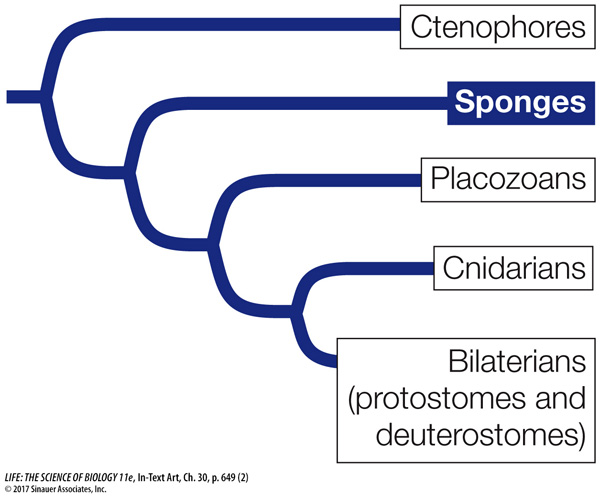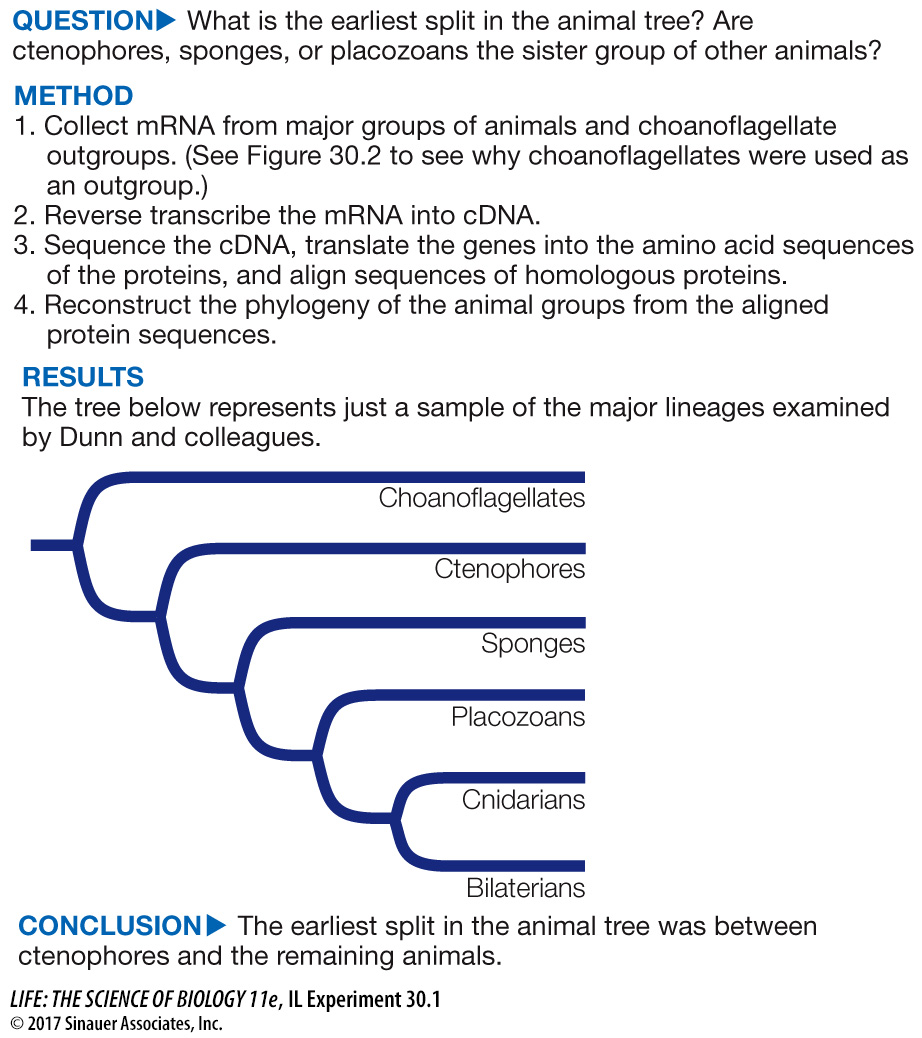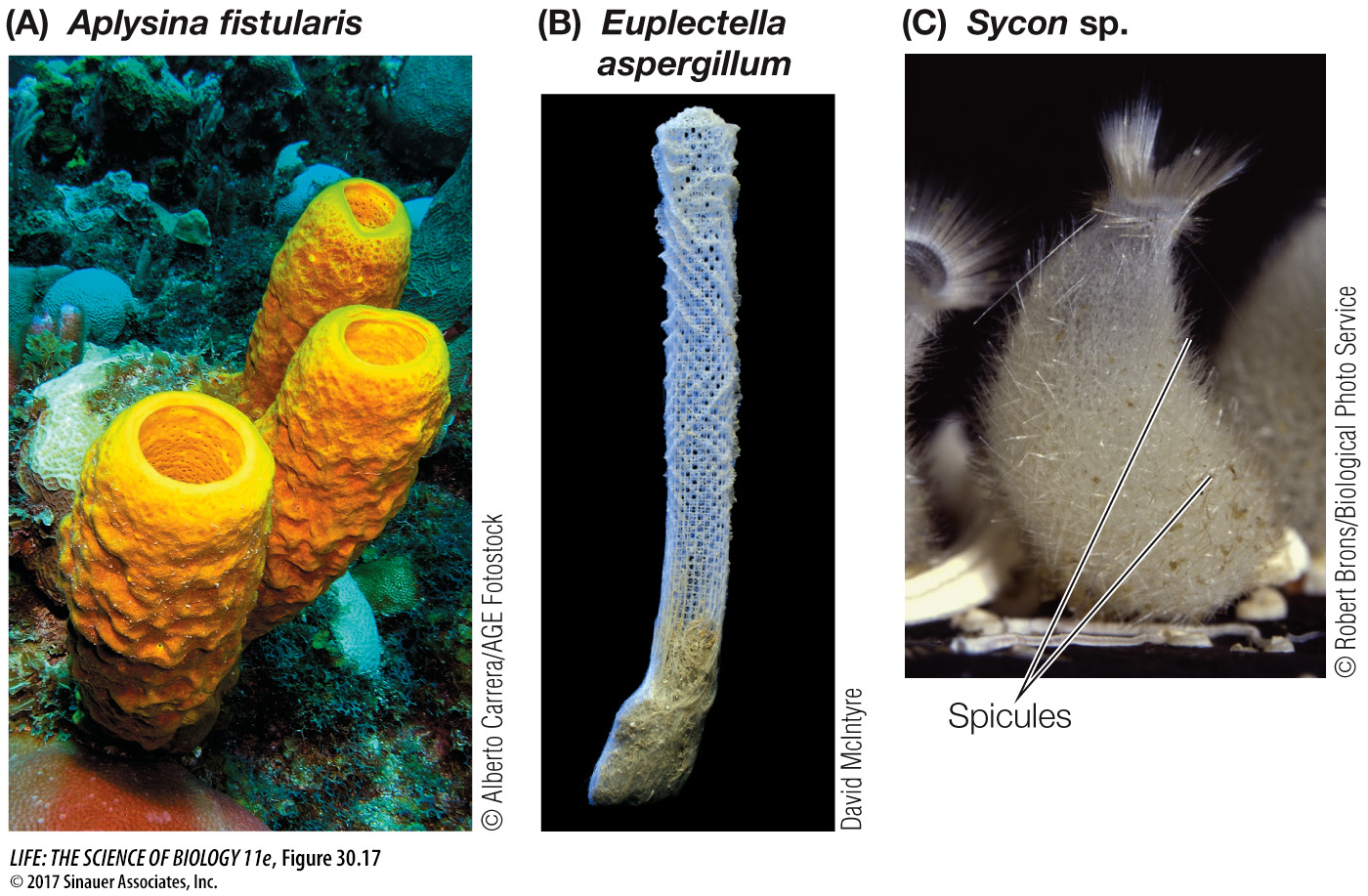Sponges are loosely organized animals

In several respects, sponges are the simplest animals. For this reason, they were long thought to be the sister group of the remaining animals, until genome sequencing placed the ctenophores in that position. But some of the perceived complexity of ctenophores now appears to have evolved independently from other animal lineages, whereas sponges have retained more of the features of the ancestral animal. Although sponges have some specialized cells, they have no distinct embryonic cell layers and no true organs. Early naturalists classified sponges as plants because they were sessile and lacked body symmetry.
investigating life
Reconstructing Animal Phylogeny from Protein-
experiment
Original Paper: Dunn, C. W. et al. 2008. Broad phylogenomic sampling improves resolution of the Animal Tree of Life. Nature 452: 745–
Several breakthroughs in our understanding of animal phylogeny have occurred in recent years as the sequences of genes and proteins have been compared across species. Casey Dunn and his colleagues compared sequences from many different proteins across a wide variety of animal groups to reconstruct their phylogeny.

work with the data
The table below includes a small sample of the data collected and analyzed by Dunn and his colleagues. Use these representative data to reconstruct a tree of the represented species. In the original paper, Dunn and colleagues reported on 11,234 amino acid positions among 77 species of animals. Twenty-
QUESTIONS
1.
Construct a phylogenetic tree of these 11 species using the parsimony method. Use the outgroup (a choanoflagellate) to root your tree. Assume that all changes from one amino acid to another are equally likely. See Key Concept 21.2 for a review of the parsimony method of reconstructing phylogenetic trees.

2.
How many character state changes (i.e., changes from one amino acid to another) occur along each branch on your tree?
Refer to figure above. The number of changes is shown on the tree for each branch; each arrow shows one change.
3.
Which characters support the ctenophores as the sister group of the remaining animals?
Amino acid positions 5 and 6, both of which exhibit the same state in ctenophores and the outgroup, but a derived state in the remaining animals, support the ctenophores as the sister group of the remaining animals.
4.
Which group on your tree represents the bilaterian animals? The protostomes? The deuterostomes?
Each of these groups is marked on the tree above (answer to Question 1).
| Character state (amino acid at position) | ||||||||||||||||||||||||||||
|---|---|---|---|---|---|---|---|---|---|---|---|---|---|---|---|---|---|---|---|---|---|---|---|---|---|---|---|---|
| Species | 1 | 2 | 3 | 4 | 5 | 6 | 7 | 8 | 9 | 10 | 11 | 12 | 13 | 14 | 15 | 16 | 17 | 18 | 19 | 20 | 21 | 22 | 23 | 24 | 25 | 26 | 27 | |
| Clam | Y | S | T | G | L | H | E | N | Y | A | R | A | M | R | I | A | L | T | I | V | K | L | S | I | V | I | L | |
| Earthworm | Y | A | T | G | L | H | E | N | Y | P | H | A | M | R | I | A | L | T | I | V | K | L | S | I | V | M | L | |
| Tardigrade | Y | A | T | G | L | H | E | H | Y | K | R | A | M | R | V | A | T | S | I | V | R | L | N | L | V | L | L | |
| Fruit Fly | F | A | T | G | L | H | E | N | Y | K | R | A | M | R | I | A | L | S | I | V | S | L | D | L | V | L | L | |
| Sea Urchin | Y | A | T | G | L | L | E | N | Y | P | N | A | M | R | I | A | L | T | V | I | R | Q | N | L | T | V | K | |
| Human | W | A | A | G | L | R | E | H | Y | P | K | A | I | R | I | S | V | T | V | I | R | Q | N | L | T | V | K | |
| Chicken | W | A | A | G | L | R | E | H | Y | P | R | A | I | R | I | A | V | T | V | I | R | Q | N | L | T | V | K | |
| Lancelet | Y | A | T | G | L | R | E | H | Y | P | K | A | M | R | I | A | V | T | V | I | R | L | N | L | T | V | K | |
| Sponge | Y | G | L | S | L | R | P | N | F | P | K | S | M | S | V | A | L | T | V | I | R | Q | N | L | V | I | L | |
| Ctenophore | Y | G | L | G | Q | D | P | N | F | P | K | S | M | S | V | A | L | T | V | I | R | Q | N | L | V | I | L | |
| Choano- |
Y | G | L | G | Q | D | P | N | F | P | K | S | F | S | V | A | L | T | V | I | R | Q | N | L | V | I | L | |
A similar work with the data exercise may be assigned in LaunchPad.
Sponges have hard skeletal elements called spicules, which may be small and simple or large and complex (see Figure 30.2B). Three major groups of sponges, which separated soon after the origin of sponges, are distinguished by their spicules. Members of two groups (glass sponges and demosponges) have skeletons composed of silicaceous spicules made of hydrated silicon dioxide (Figure 30.17A and B). These spicules are remarkable in having greater flexibility and toughness than synthetic glass rods of similar length. Members of the third group, the calcareous sponges, take their name from their calcium carbonate spicules (Figure 30.17C). There is some question about the monophyly of sponges, although genomic analyses that combine information from many genes support their monophyly.

The body plan of sponges of all three groups—
A skeleton of simple or branching spicules, often combined with a complex network of elastic fibers, supports the body of most sponges. Sponges also produce an extracellular matrix, composed of collagen, adhesive glycoproteins, and other molecules, that holds the cells together. Most species are filter feeders; a few species are predators that trap prey on hook-
Most of the 8,500 species of sponges are marine animals; only about 50 species live in fresh water. Sponges come in a wide variety of sizes and shapes that are adapted to different movement patterns of water. Sponges living in intertidal or shallow subtidal environments with strong wave action are firmly attached to the substrate. Most sponges that live in slowly flowing water are flattened and are oriented at right angles to the direction of current flow. They intercept water and the food items it contains as it flows past them.
Sponges reproduce both sexually and asexually. In most species, a single individual produces both eggs and sperm, but individuals do not self-